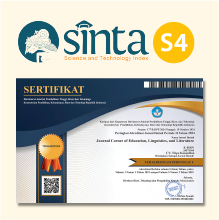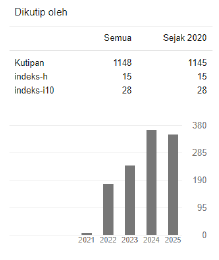Students' Challenges of Blended Learning Model in Higher Education
 https://doi.org/10.54012/jcell.v2i3.123
https://doi.org/10.54012/jcell.v2i3.123
 Abstract views: 2870
Abstract views: 2870
 PDF downloads: 1571
PDF downloads: 1571
Keywords:
blended learning, challenges, higher educationAbstract
Blended learning is a general term for a method that combines the benefits of classroom learning with online learning. However, the combination of online and face-to-face educational components has caused problems over time. Some studies highlight the general limitations of the blended learning education model, but there is no clear insight into the challenges that exist in the blended learning online component. A systematic literature search was performed to identify obstacles to the online components of blended learning from a student's perspective. The biggest challenges students face are self-regulatory issues and the difficulty of learning technology. This study highlights the need for further research to address the problem of student blended learning.
Downloads
References
Akçayır, G., & Akçayır, M. (2018a). The flipped classroom: A review of its advantages and challenges. Computers & Education, 126, 334–345. https://doi.org/10.1016/J.COMPEDU.2018.07.021
Akçayır, G., & Akçayır, M. (2018b). The flipped classroom: A review of its advantages and challenges. Computers & Education, 126, 334–345. https://doi.org/10.1016/J.COMPEDU.2018.07.021
AlJarrah, A., Thomas, M. K., & Shehab, M. (2018). Investigating temporal access in a flipped classroom: procrastination persists. International Journal of Educational Technology in Higher Education, 15(1). https://doi.org/10.1186/s41239-017-0083-9
Alsobhi, R. M. (2021). Factors to Consider for Implementing Blended Learning in Saudi Higher Education Institutions: An Integrative Literature Review. Dissertaion, Virginia Polytechnic and State University.
Boelens, R., de Wever, B., & Voet, M. (2017). Four key challenges to the design of blended learning: A systematic literature review. Educational Research Review, 22, 1–18. https://doi.org/10.1016/J.EDUREV.2017.06.001
Borup, J., West, R. E., Thomas, R. A., & Graham, C. R. (2014). Examining the impact of video feedback on instructor social presence in blended courses. International Review of Research in Open and Distance Learning, 15(3), 232–256. https://doi.org/10.19173/IRRODL.V15I3.1821
Branch, J., & Rocchi, F. (2015). Concept Development: A Primer. Philosophy of Management 2015 14:2, 14(2), 111–133. https://doi.org/10.1007/S40926-015-0011-9
Broadbent, J. (2017). Comparing online and blended learner’s self-regulated learning strategies and academic performance. The Internet and Higher Education, 33, 24–32. https://doi.org/10.1016/J.IHEDUC.2017.01.004
Brown, M. G. (2016). Blended instructional practice: A review of the empirical literature on instructors’ adoption and use of online tools in face-to-face teaching. The Internet and Higher Education, 31, 1–10. https://doi.org/10.1016/J.IHEDUC.2016.05.001
Chen, S. C., Yang, S. J. H., & Hsiao, C. C. (2016). Exploring student perceptions, learning outcome and gender differences in a flipped mathematics course. British Journal of Educational Technology, 47(6), 1096–1112. https://doi.org/10.1111/BJET.12278
Chuang, H. H., Weng, C. Y., & Chen, C. H. (2018). Which students benefit most from a flipped classroom approach to language learning? British Journal of Educational Technology, 49(1), 56–68. https://doi.org/10.1111/BJET.12530
Chyr, L., Yapici, H., & Padula, W. (2018). Cost-Effectiveness of Donepezil in the Treatment of Patients With Alzheimer’s Disease: An Update. Value in Health, 21. https://doi.org/10.1016/j.jval.2018.04.1399
Dannenberg, P., Fuchs, M., Riedler, T., & Wiedemann, C. (2020). Digital Transition by COVID-19 Pandemic? The German Food Online Retail. Tijdschrift Voor Economische En Sociale Geografie, 111(3). https://doi.org/10.1111/tesg.12453
Dziuban, C., Graham, C. R., Moskal, P. D., Norberg, A., & Sicilia, N. (2018a). Blended learning: the new normal and emerging technologies. International Journal of Educational Technology in Higher Education, 15(1), 1–16. https://doi.org/10.1186/S41239-017-0087-5/TABLES/6
Dziuban, C., Graham, C. R., Moskal, P. D., Norberg, A., & Sicilia, N. (2018b). Blended learning: the new normal and emerging technologies. International Journal of Educational Technology in Higher Education, 15(1), 1–16. https://doi.org/10.1186/S41239-017-0087-5/TABLES/6
Farrah, M., & Hatem Al-Bakry, G. (2020). Online learning for EFL students in Palestinian universities during Corona pandemic: advantages, challenges and solutions. Indonesian Journal of Learning and Instruction, 3(2).
Garrison, D. R. (2016). E-learning in the 21st century: A community of inquiry framework for research and practice, third edition. E-Learning in the 21st Century: A Community of Inquiry Framework for Research and Practice, Third Edition, 1–202. https://doi.org/10.4324/9781315667263/LEARNING-21ST-CENTURY-RANDY-GARRISON
Giuliano, C. A., & Moser, L. R. (2016). Evaluation of a Flipped Drug Literature Evaluation Course. American Journal of Pharmaceutical Education, 80(4). https://doi.org/10.5688/AJPE80466
Hamburg, I. (n.d.). Creating Innovative Structures in Workplace and Vocational Digital Learning to Ensure Social Distancing.
Hrastinski, S. (2019). What Do We Mean by Blended Learning? TechTrends, 63(5). https://doi.org/10.1007/s11528-019-00375-5
Kim, M. K., Kim, S. M., Khera, O., & Getman, J. (2014). The experience of three flipped classrooms in an urban university: an exploration of design principles. The Internet and Higher Education, 22, 37–50. https://doi.org/10.1016/J.IHEDUC.2014.04.003
Li, Q., Li, Z., & Han, J. (2021). A hybrid learning pedagogy for surmounting the challenges of the COVID-19 pandemic in the performing arts education. Education and Information Technologies, 26(6). https://doi.org/10.1007/s10639-021-10612-1
Lin, J. W., Lai, Y. C., Lai, Y. C., & Chang, L. C. (2016). Fostering self-regulated learning in a blended environment using group awareness and peer assistance as external scaffolds. Journal of Computer Assisted Learning, 32(1), 77–93. https://doi.org/10.1111/JCAL.12120
Mason, G. S., Shuman, T. R., & Cook, K. E. (2013). Comparing the effectiveness of an inverted classroom to a traditional classroom in an upper-division engineering course. IEEE Transactions on Education, 56(4), 430–435. https://doi.org/10.1109/TE.2013.2249066
Maycock, K. W., Lambert, J., & Bane, D. (2018). Flipping learning not just content: A 4-year action research study investigating the appropriate level of flipped learning. Journal of Computer Assisted Learning, 34(6), 661–672. https://doi.org/10.1111/JCAL.12274
McCallum, S., Schultz, J., Sellke, K., & Spartz, J. (2015). An Examination of the Flipped Classroom Approach on College Student Academic Involvement. International Journal of Teaching and Learning in Higher Education, 27(1), 42–55. http://www.isetl.org/ijtlhe/
OECD. (2013). Education at a Glance 2013 - Statistics. In Oecd (Issue September). http://www.oecd-ilibrary.org/education/education-at-a-glance-2013_eag-2013-en;jsessionid=4qrj2lt4d2oge.x-oecd-live-01
Özmen, B., & Atici, B. (2014). Learners’ Views Regarding the Use of Social Networking Sites in Distance Learning. International Review of Research in Open and Distributed Learning, 15(4), 21–42. https://doi.org/10.19173/IRRODL.V15I4.1790
Özmen, B., & Atıcı, B. (2014). The Effects of Social Networking Sites in Distance Learning on Learners’ Academic Achievements. European Journal of Open, Distance and E-Learning, 17(2), 61–75. https://doi.org/10.2478/EURODL-2014-0019
Prasad, P. W. C., Maag, A., Redestowicz, M., & Hoe, L. S. (2018). Unfamiliar technology: Reaction of international students to blended learning. Computers & Education, 122, 92–103. https://doi.org/10.1016/J.COMPEDU.2018.03.016
Redecker, C., & Punie, Y. (2014). The Future of Learning 2025: Developing a vision for change. Future Learning, 2(1), 3–17. https://doi.org/10.7564/13-fule12
Safford, K., & Stinton, J. (2016). Barriers to blended digital distance vocational learning for non-traditional students. British Journal of Educational Technology, 47(1), 135–150. https://doi.org/10.1111/BJET.12222
Salim, H., Lee, P. Y., Ghazali, S. S., Ching, S. M., Ali, H., Shamsuddin, N. H., Mawardi, M., Kassim, P. S. J., & Dzulkarnain, D. H. A. (2018). Perceptions toward a pilot project on blended learning in Malaysian family medicine postgraduate training: A qualitative study. BMC Medical Education, 18(1), 1–10. https://doi.org/10.1186/S12909-018-1315-Y/TABLES/4
Sun, J. C. Y., Wu, Y. T., & Lee, W. I. (2017). The effect of the flipped classroom approach to OpenCourseWare instruction on students’ self-regulation. British Journal of Educational Technology, 48(3), 713–729. https://doi.org/10.1111/BJET.12444
Szeto, E., & Cheng, A. Y. N. (2014). Towards a framework of interactions in a blended synchronous learning environment: what effects are there on students’ social presence experience? Http://Dx.Doi.Org/10.1080/10494820.2014.881391, 24(3), 487–503. https://doi.org/10.1080/10494820.2014.881391
Thoms, B., & Eryilmaz, E. (2014). How media choice affects learner interactions in distance learning classes. Computers & Education, 75, 112–126. https://doi.org/10.1016/J.COMPEDU.2014.02.002
Yeou, M. (2016). An Investigation of Students’ Acceptance of Moodle in a Blended Learning Setting Using Technology Acceptance Model. Http://Dx.Doi.Org/10.1177/0047239515618464, 44(3), 300–318. https://doi.org/10.1177/0047239515618464
Zacharis, N. Z. (2015). A multivariate approach to predicting student outcomes in web-enabled blended learning courses. The Internet and Higher Education, 27, 44–53. https://doi.org/10.1016/J.IHEDUC.2015.05.002
Downloads
Published
How to Cite
Issue
Section
License
Copyright (c) 2023 Lanlan Muhria, Nana Supriatna, Nunu Nurfirdaus

This work is licensed under a Creative Commons Attribution-ShareAlike 4.0 International License.
All articles published in the Journal Corner of Education, Linguistics, and Literature are licensed under the Creative Commons Attribution-ShareAlike License (CC BY-SA).

















